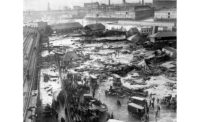Harvey may have been downgraded from hurricane status to tropical storm, but it continues to produce extraordinary amounts of rain, bringing misery to residents of southeastern Texas and southwestern Louisiana. Forecasters say the area can expect heavy rain to persist throughout the Labor Day weekend.
Currently at three, the death toll is expected to rise. Relatives believe that six family members trying to escape the floodwaters in a van were swept to their death, but those fatalities have not yet been confirmed.
Flooding hazards
The CDC is issuing a sobering reminder: each year, more deaths occur due to flooding than any other hazard related to thunderstorms. The most common flood deaths occur when a vehicle is driven into hazardous flood water.
Fortunately, you can take steps to protect yourself, your family, and your home.
During a Flood Watch or Warning
- Gather emergency supplies.
- Listen to your local radio or television station for updates.
- Have immunization records handy (or know the year of your last tetanus shot).
- Store immunization records in a waterproof container.
- Fill bathtubs, sinks, gallon jars, and plastic soda bottles so that you will have a supply of clean water.
- Sanitize sinks/tubs first by cleaning them using a solution of one cup of bleach to five gallons of water. Then rinse and fill with clean water.
- Bring in outdoor possessions (lawn furniture, grills, trash cans) or tie them down securely.
- If evacuation appears necessary: turn off all utilities at the main power switch and close the main gas valve.
- Leave areas subject to flooding: low spots, canyons, washes, etc. (Remember: avoid driving through flooded areas and standing water.)
- After you return home, if you find that your home was flooded, practice safe cleaning.
After Flooding Has Occurred
- Avoid driving through flooded areas and standing water. As little as six inches of water can cause you to lose control of your vehicle.
- Do not drink flood water, or use it to wash dishes, brush teeth, or wash/prepare food. Drink clean, safe water.
- If you evacuated: return to your home only after local authorities have said it is safe to do so.
- Listen to water advisory from local authorities to find out if your water is safe for drinking and bathing.
- During a water advisory, use only bottled, boiled, or treated water for drinking, cooking, etc.
- When in doubt, throw it out! Throw away any food and bottled water that comes/may have come into contact with flood water.
- Prevent carbon monoxide (CO) poisoning. Use generators at least 20 feet from any doors, windows, or vents. If you use a pressure washer, be sure to keep the engine outdoors and 20 feet from windows, doors, or vents as well.
- The initial damage caused by a flood is not the only risk. Standing flood waters can also spread infectious diseases, bring chemical hazards, and cause injuries.
- After you return home, if you find that your home was flooded, practice safe cleaning. Remove and throw out drywall and insulation that was contaminated with flood water or sewage. Throw out items that cannot be washed and cleaned with a bleach solution: mattresses, pillows, carpeting, carpet padding, and stuffed toys. Homeowners may want to temporarily store items outside of the home until insurance claims can be filed. See recommendations by the Federal Emergency Management Agency (FEMA).
- Walls, hard-surfaced floors, and many other household surfaces should be cleaned with soap and water and disinfected with a solution of one cup of bleach to five gallons of water.
More Information
- CDC’s Hurricane Site(https://www.cdc.gov/disasters/hurricanes/index.html)
- FEMA’s Hurricane Harvey Information
- USA.gov’s Hurricane Harvey Information
- Be Ready! Floods infographic https://www.cdc.gov/phpr/documents/beready_floods.pdf
- CDC’s extensive information on flooding





